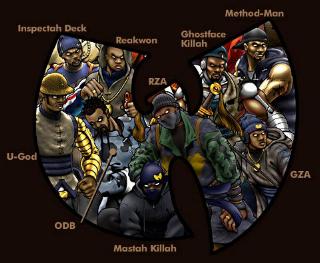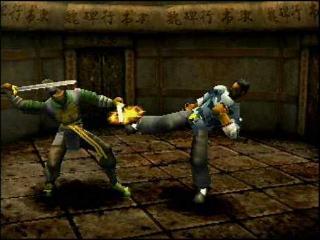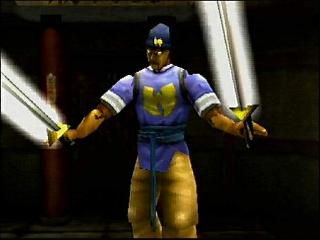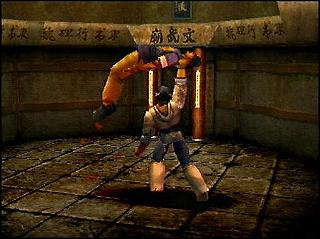
Grab three of yo homies and get ready to bring the pain!
Rated:

Posted on: 12/8/99
I'm not going to pretend to be a big fan of the Wu-Tang Clan, because I donít own a single one of their albums, but I am certainly a fan of action-packed fighting games. This game is based on the infamous Thrill Kill game engine, developed by Paradox, who with the help of Activision has brought us an innovative multi-player fighting game (up to four players at once) featuring all nine members of the Wu-Tang Clan rap group.

| |
| Here's the entire Wu-Tang gang ready to bust out some phat moves and dope rhymes. | |
Right off the bat, I must comment on the unique cast of characters. The last game I can remember playing that had an exclusive cast of African-American lead characters was a tank game called Shell Shock. This is a refreshing change of pace from the usual cookie-cutter cast of characters that are present in many fighting games. The Wu-Tang Clan definitely bring a sort of grittiness and urban appeal that nicely contrasts the ancient Chinese theme of the game.
The characters are all well modeled. Initially, nine fighters are available, each having his or her own special abilities. Additional characters and bosses will become unlocked as you open "chambers." The character design remains fresh even when compared with some of the more popular fighting series (i.e., Virtua Fighter, Tekken, Street Fighter, etc.). Yet, a couple of the boss characters look like they were ripped straight out of a movie. One of the female boss characters is a Cleopatra Jones look-alike, and another one looks like he was taken from the movie Big Trouble in Little China. The animation, on the other hand, comes up a bit short when compared with that of a Virtua Fighter or Tekken. To be fair, neither of those games had to contend with up to four characters battling it out on-screen. Each character has a nice set of moves, and the included Practice mode will help you learn each of them. The Practice mode isnít as option packed as some of the other Practice modes included in todayís fighting games, but it certainly gets the job done.
There is also a Story mode included in the game. This is a one-player mode where you choose to play as one of the nine Wu-Tang members and embark on a quest to save your kidnapped master. The story line is as good as your average American-dubbed kung fu movie, and it contains some nicely done cut-scenes that serve to move the story along. The voice acting in these scenes is competent, but obviously none of the Wu-Tang members deliver "Hollywood" quality voice acting. These guys are rap stars, and it is during the rap songs in the game where their voices shine.
If nothing else, the Story mode provides the player with an incentive to unlock the 36 chambers for each character. To fill these chambers, players must meet a variety of objectives, ranging from blocking a set number of attacks to performing multi-hit combos. Every time colored groups (blue, red, green, etc.) of individual chambers are filled, the game rewards the player with a variety of extras and secrets. These range from additional fatality moves to extra characters. This provides a good enough reason to continue playing through the Story mode with each character. Indeed, some of the more gruesome fatalities that are unlocked may be worth the price of admission alone for some gamers. Still, I found it hard to return to the single-player game after experiencing the multi-player mode, especially since the single-player experience here doesnít compare favorably with that of the great fighters on the market today.

| |
| ODB (pictured on the right) uses a drunken fighting style similar to Shun Di's of Virtua Fighter 2 fame. | |
Unlike in most fighting games, there are no rounds dividing the action. Instead, a series of victories over your opponent(s) gives you the win. Likewise, after you have been defeated several times the game will end, but you will have a chance to continue from the point where you left off. You also begin in a hub ŗ la Crash Bandicoot 2 & 3 where you are able to choose the path to the arenas where the fights take place. Warps eventually appear in the hubs and will transport you to a new area once it is available.
The control scheme is similar to the one in Tekken, with two individual punch and kick buttons. There are also block and crouch moves mapped to the L1 & L2 buttons, respectively. Of course, if you are unhappy with the default controls, you can always change them to suit your fighting style. You even have the option of selecting a Turbo Mode to speed up the action during fights.
The actual fighting resembles more of a beat-íem-up than it does a traditional fighting game. You will often evade or circle your opponent rather than take the fight straight to him or her. This is especially true when facing multiple opponents. However, I donít want to make it seem like Wu-Tang lacks depth, because it certainly contains its fair share. In fact, mindlessly mashing buttons will only get you so far. You must develop a sense of timing and plan your attacks before executing them. Itís not rocket science, but you will have to come up with a strategy when dealing with multiple opponents and facing tough bosses. Fortunately, every now and again, a fellow Wu-Tang member will lend a helping hand during a fight in the Story mode.

| |
| You've got to have serious skillz to wield blades like these! | |
To aid you in your fighting, each character has a Rage Meter, located under the health bar, that will gradually increase as you inflict damage to your opponents or block one of their attacks. Once you fill the Rage Meter, you can press all four buttons (Triangle, Circle, Square, and X) to enter "Double-D" mode, where your attacks will cause twice the amount of damage. While in Double-D mode, you will notice an aura of swirling balls, which eventually disappear when your rage meter wears down.
What will make this game an instant buy for some is the Versus mode, in which a Multi Tap is almost required to get the most enjoyment. It should be noted that this is one of the first games on PlayStation to let four players duke it out simultaneously. Wu-Tang also creates a very convincing argument for purchasing a Multi Tap if you donít already own one.
While you can play the Versus mode with one friend, or even alone with the computer-controlled opponents, this game really shines when you have three of your "homies" sitting by your side. You can opt to have an all-out brawl or choose to split into teams. Whichever way you decide to play, prepare yourself for some intense action. The arenas are small enough to begin with, but when you add an additional three fighters to the mix they feel very claustrophobic. There is an occasional frame-rate drop, and the action does become chaotic at times, but it never really detracts from the fun that is multi-player fighting.
Since this game does contain the Wu-Tang Clan, expect to hear rap music throughout the entire game (Wu-Tang supplied three exclusive tracks for the game). Rap is not my favorite type of music, but it never distracted me from the fighting. Most of the Wu-Tang members even provided some decent voice-overs. Ironically, though, I found the non–Wu-Tang songs and voice-overs to be of much higher quality, from a technical standpoint.

| |
| What goes up must come down. | |
Wu-Tang contains its share of graphical insufficiencies. For one, the graphics arenít anything to write home about, and the backgrounds are especially lacking. Most of them are dark, bland, and suffer heavily from pixellation. The fighters lack detail and look a little blocky when compared with characters in other fighting games available for the PlayStation. However, this is an easy flaw to put aside when you consider that multiple fighters are usually present on-screen. There also were not many special effects during the actual fighting that excited me, although the Matrix-style effect displayed before each characterís fatality move is wonderfully done.
Which brings me to the final issue about the game — the fatalities. Although I did enjoy watching the fatalities, which included decapitated heads (among other things) and liberal amounts of blood splatter, they became really gratuitous and boring in nature. It seemed like some of the fatalities were added just so more blood could spill in the game, with no effort being needed by the player to execute any of them (unless you consider a single button press to be a great deal of effort). At least the Mortal Kombat series made the player work for the fatality scene and usually rewarded him or her with something memorable. I must say, though, the presentation of the fatalities in Wu-Tang is great, but repetitive nonetheless. Just be thankful the game contains a Parental Lockout requiring players to input a code to enable the blood and fatalities. I can only imagine the outrage this title would have caused among parental and Christian groups if not for this little "safety" feature, coupled with the M rating the game received. The Parental Lockout feature may even please Joseph Lieberman, one of the Senators who helped impose a mandatory rating system on games.
Simply put, Wu-Tang: Shaolin Style is at its best when multiple players are involved, but the one-player Story mode does contain some worth and replay value. This game should also appeal to the Wu-Tang Clan fans out there, although they shouldn't expect to be blown away by the rappers' voice acting and substandard music tracks. In the end, this is a must-have game for anyone who owns a Multi Tap. Fighting fans looking for a good single-player game, however, may want to try this one first before committing to a purchase.
Supports:
- Multi Tap (recommended)
- Memory Card
- Vibration Function